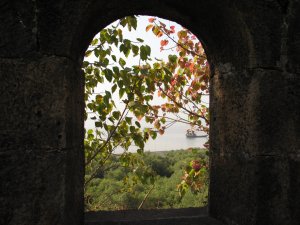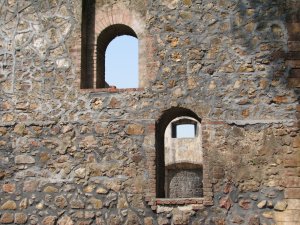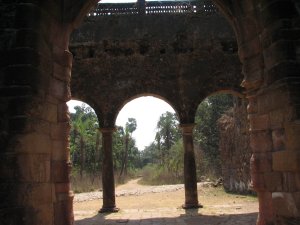

A brief history of fort is available at Wikipedia entry on the same. Also I found this site very informative with some original images of the fort. The Fort was won by Marathas under Chimaji Appa in 1739, with much casualties, before that it was the Portuguese capital of North Konkan. When in its full glory the Vasai fort must have been wonderful. Even the ruins of the fort are magnificent. You get a feeling of being transformed into their era when you are in them.
The auto took us to the fort jetty by a straight road which goes through the fort. The jetty is at the southern end of the fort. From the jetty there is a gate to enter the fort. This is one of the original entrances to the fort, and was known as Porta do Mor. The other gate is on the land side of the fort and appropriately called Porta da Terra [This one we could not see, as we did not know that it existed, when we went to the fort]. There are two baobab trees at the entrance. The baobab trees are native of Africa, were supposedly introduced by the Portuguese in the area. Actually Sunjoy Monga’s book Mumbai Nature Guide lists Vasai fort as one of the sites which harbors the baobab trees in the vicinity of Mumbai, about 6 specimens are listed, out of which we could see 5. We missed a really large one which is at the right to the sea side entrance of the fort. The species that we have here is Adansonia digitata [known as गोरख चिंच [gorakh chinch] locally]. For interesting information see www.baobab.com


One interesting thing to note is that there still is a full wooden door, with all its ornamentation. I doubt it is the original one but it was a pleasant surprise nonetheless. As you enter the fort from this side there is a small temple on the left hand side, which was established by Chimaji Appa, when the fort was won.

The inner gate also has its wooden door intact.

We went up the stairs that are behind the small temple, which is one of the ten bastions of the fort [Though at that time we did not know that is was a bastion]. There were trees growing on the bastion floor!


The windows of the bastion overlook the Bassien creek and give a nice view of the mangroves below and the fishing ships beyond.


Sumit in one of th
e windows.

On the bastion a vine with yellow flowers was in full bloom. Ritesh the best taxonomer I know was not able to identify it [Id anybody?]. The plant was identified by Samir as Yellow Trumpet Creeper Macfadyena unguis-cati, also called Cat’s Claw. See the comment.
Then we went on to a cathedral. Deja-vu!! Simply because this location has been used in a lot of movies and also videos. Anyways the ceiling of one part of the cathedral is still intact. Though it has lost its lustre it must have been really magnificent.

This was our first major halt in the fort. The cathedral also has spiral staircase, which is very unique in construction. The steps and the axis are carved out in a single stone. See the picture and you will probably understand. Here again the bane of Indian archaeological sites viz. graffiti is abound. Some people are trying to make themselves known to the world at the cost of damaging and ruining our cultural heritage. Yuck!! I don’t know with what mentality people do this, are they trying to claim the place for themselves? Shame on them.
The tower below I guess is the highest point in what remains in the fort. There were parakeets on the overgrown trees on the top. Mr. Jagdale was full of adrenaline and he went along the walls to the otherside of the tower structure where this wonderful ceiling is present. He told that the ceiling part has been reinforced with concrete.

Here a lot of birds were seen, but could not ID[anyway I am not good at it] or take a shot at them. One bird of prey was in the sky above but did not get a good shot at it. [It is at moments like this I miss the telephoto lens 🙁 which I do not have].
We walked through dense cover of trees through a path, which took us to the citadel of the fort. The most prominent trees are mango [which was in full bloom], tamarind and dates.
The citadel of the fort has an entrance which is small but very beautiful. There must have been a statue on the door; an empty space is a reminder of that. This is the initial fort of St. Sebastian which was extended into the larger fort.

The Portuguese coat-of-arms on the gate.

Here you can see two non-pillars; see the photo and you will understand.

There were fisher folks in the fort trying to process their webs with some sort of dye. Inside the citadel there is a small pond, which had some herons in it. We went along the wall to the end of it near a bastion. This bastion is circular though. When we went out of the citadel, we came up to the senate house of the fort. Next to the senate house is the lake which is almost at the center of the fort. Along side the lake are two temples, one of Vajreshwari and Nageshwar.
From here we took a right turn, where there were more ruins.


A stone plate with something in roman script [Can anyone translate this?].
 From here we went inside towards the unknown, there were people sitting we asked them about more places to visit. They said that one of the old churches has been restored recently and that we should see it. They were the guardians of the mangoes of the fort. We went by the way told by the guardians and landed up at another place, which Wikimapia says is the Old Convent of St. Anthony.
From here we went inside towards the unknown, there were people sitting we asked them about more places to visit. They said that one of the old churches has been restored recently and that we should see it. They were the guardians of the mangoes of the fort. We went by the way told by the guardians and landed up at another place, which Wikimapia says is the Old Convent of St. Anthony.
Now this was an awesome place.


Arches are numerous as can be seen from the photos below.


One of the features of this place is the fact that the floor here has many graves. Some of them have coat of arms inscribed on them and some have names and the year of the burial all in roman script.

 From the inside of the convent.
From the inside of the convent.


Then after this we went to the restored Augustinian Convent. Most of the restoration is of concrete :(.

Some initials which I would like to decipher. The date inscribed is 1626.

But the ceiling is all wood, and I guess has been done as it actually was.

From here on we hit back to the citadel where we came from. After pas
sing the Nageshwar temple we came to the ruins of the Dominican convent. This is another place undergoing restoration. Lots of re-construction going on. This was also a hospital.

 Is not the statue missing?
Is not the statue missing?
 The coat of arms here too…
The coat of arms here too…

There was I guess a bell tower also here. From there we get to the main straight road which goes to the fort jetty. And across the road is the statue of the Chimaji Appa who captured the fort in 1739 from the Portuguese.

When the fort did not yield quickly Chimaji Appa said:
किल््ला हाती येत नाही, तर निदान माझे मस््तक तरी तोफेने उडवुन ते किल््लयात जाऊन पडेल असे करा.
Meaning: fort is not yet conquered, then put my head on the canon and at least make sure it lands inside the fort.
The geography of the Vasai fort is such that it allows attack option from the North only. On two sides the sea shore is there. And there are marsh lands on the other sides so blasting the walls with mines was not easy. But ultimately mines were laid and the Marathas got the entry through the Sebastian Bastion. Heavy casualties were inflicted on the Maratha side, about 12,000 as compared to about 800 on the Portuguese side. The Portuguese lost most of their generals and officers and the surrender was done by a Captain. The victory was described by Chimaji Appa thus:
या मागे युद््धे बहुत प््रापत झाली, परंतु मराठी फौजेस यासारखे युद््ध पडले नाही. सीमासीमाच केली. त््याचा िवस््तार िलहता विस््तार आहे. या जागा फत््ते होणे देवाची दया आहे.
Meaning [As I have understood, If you have understood it differently please let me know]: Before this Marathas have won many battles, but none like this one. This cannot be captured in words and this victory is beyond description. Conquest of this place is a grace of God.
The survivors were given a safe passage out of the fort and 8 days to take away movable properties. The fort and the buildings were ransacked and the bells in the churches were taken as mementos of victory. Two of the bells were installed at temples in Nashik and Sudhagad. You can see the pictures of the two
here.
There is a small entrance here, which leads you out in the marshlands ahead. I took some shots of the bastions as they are seen from the ground level.
This was the end of our journey, we took an auto back to Vasai road station.
But this is one place I would surely like to visit in the Monsoons.
Now the journey continues to the next destination the Island fort of Arnala, but that will be another blog…












































